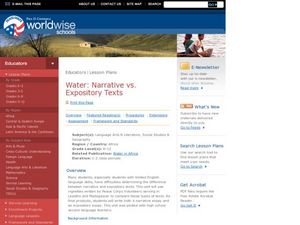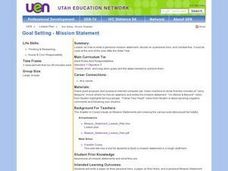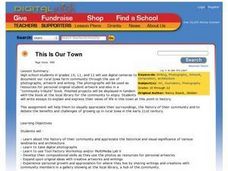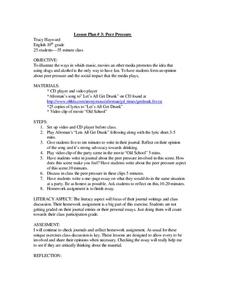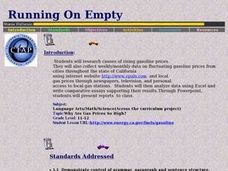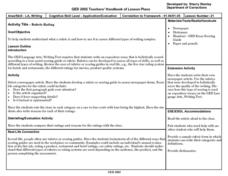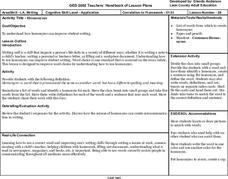Curated OER
2005 USDA Food Guide
In this food pyramid worksheet, 4th graders will answer 6 multiple choice questions about the newest version of the food pyramid (released in 2005), compare and contrast the old and new food guide using a Venn diagram, write a brief...
Curated OER
What's Down There
Students write an essay about the coral reefs. In this oceanography lesson plan, students investigate the reef of Bonaire and compare it to reefs that are not thriving. Students then explore the differences that contribute to the...
Curated OER
Jewish Folktales
Students write an essay and create illustrations of Jewish culture. For this literature-response lesson plan, students read various Jewish folktales. As they read, students study the geographical, cultural, and historical background of...
Curated OER
Biography Report- Learning Microsoft Word
Students learn how to use Microsoft Word. In this biography lesson, students participate in mini-lessons on key features of Microsoft Word and then use it to write a multi-part biography report.
Curated OER
Frog Questions
In this frogs worksheet, students first choose a type of frog and research facts about it. Students answer 7 essay questions about habitat, food, body adaptation and protection.
Curated OER
New York State Testing Program: English/Language Arts Book 2, Grade 4
This 4th grade English/Language Arts standardized test practice activity assesses listening skills. Testers respond to short answer questions and an open-ended essay question.
Curated OER
Ethics and Philanthropy The Act of Sharing and Giving
Learners define ethics, and identify ways that they have practiced philanthropy in their own family. They listen to a book, write an essay, and identify a role model for philanthropy.
Curated OER
Narrative Peer Editing Worksheet
Need a template for a narrative peer editing worksheet? Reviewers use this worksheet to record their responses to a classmate’s story, commenting on the effectiveness of the story’s introduction, conflict, character development, etc.
Curated OER
Water: Narrative vs. Expository Texts
A reading of vignettes written by Peace Corps Volunteers serving in Lesotho and Madagascar launches a study of the difference between narrative and expository texts. As final products, young writers craft both a narrative and an...
Curated OER
Me and My Logo
Students design their own emblem. In this introduction lesson plan, students get to know one another by designing an emblem that combines symbols that represent themselves. They express themselves to their classmates.
Grammar Net
Adjectives of Comparison
Is our car bigger than theirs? Is this car better than than that one? Use comparative and superlative adjectives of provided verbs to complete twenty sentences.
National Constitution Center
Born in the U.S.A: Music as Political Protest
Though often used in shows of patriotism, Bruce Springsteen's 1985 song "Born in the U.S.A." is critical of America's role in the Vietnam war and its treatment of American veterans. High schoolers analyze the song's lyrics in an activity...
University of Pennsylvania
Decoding Propaganda: J’Accuse…! vs. J’Accuse…!
Reading snail mail is a great way to go back into history and to understand others' points of view. The resource, the second in a five-part unit, covers the Dreyfus Affair. Scholars, working in two different groups, read one letter and...
Curated OER
Parrot in the Oven: Pre-Reading Strategy: 4 Corners
A four corners pre-reading activity introduces class members to the major themes in Victor Martinez's award winning novel, Parrot in the Oven: Mi Vida.
Novelinks
The Tempest: Concept Analysis
Use a handy concept analysis guide as you begin your unit on William Shakespeare's The Tempest. With character descriptions, literary themes, and anticipated affective issues, the guide can help those new to using The Tempest craft a...
Amnesty International
Respect My Rights, Respect My Dignity: Module One – Poverty and Human Rights
Creating an environment where learners feel both educated and empowered challenges any teacher when discussing a sometimes bleak topic. A respectful resource provides them with the details and permits them to make a plan of action....
Curated OER
Goal Setting -- Mission Statements
Students read examples of mission statements related to goal setting. Individually, they research accomplishments of their hero and how they overcame fear. To end the lesson, they write their own mission statement on how they plan to...
Curated OER
This Is Our Town
Students use digital cameras to document their community through the use of photographs, artwork and writing. They create a community tribute book that includes essays, artwork and pictures. Afterwards, they debate the benefits and...
Curated OER
Peer Pressure
Eleventh graders analyze the social impact media plays in relation to peer pressure. In this peer pressure activity, 11th graders listen to Afroman's "Lets All Get Drunk" and read the lyrics. Students write about the song and view a...
Curated OER
Running On Empty
Students research causes of rising gasoline prices. They collect data on fluctuating gasoline prices and analyze the data using Excel. They write comparative essays supporting their results and create PowerPoint presentations to present...
Curated OER
Rubric Rating
Students develop a rubric or scoring guide to assess newpaper articles. They rate the story and write the reasons for the rating. An Essay Scoring Guide is attached for reference.
Curated OER
The Chinese Rites Controversy: A Case Study in Cross-Cultural Exchange and Cross-Cultural Conflict
High schoolers examine the various groups involved in the Rites Controversy of China. They participate in a simulation of representatives involved in the Rites Controversy, conduct research, write a persuasive paper, and participate in a...
Curated OER
What is reconciliation?
Tenth graders practice using empathy with an enemy. In this Current Events lesson, 10th graders prepare possible peace plans for Bosnia after the war. Students write a report on Nelson Mandela's use of reconciliation in South Africa.
Curated OER
Homonyms
Students brainstorm a list of words and identify a homonym for each. They write definitions for each of the words and a sentence that uses each word. A list of common homonyms is attached.










